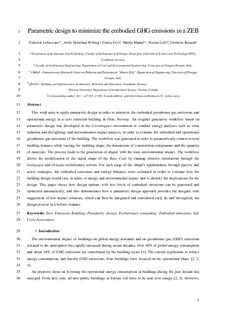| dc.contributor.author | Lobaccaro, Gabriele | |
| dc.contributor.author | Houlihan Wiberg, Aoife Anne Marie | |
| dc.contributor.author | Ceci, Giulia | |
| dc.contributor.author | Manni, Mattia | |
| dc.contributor.author | Lolli, Nicola | |
| dc.contributor.author | Berardi, Umberto | |
| dc.date.accessioned | 2019-02-13T15:08:15Z | |
| dc.date.available | 2019-02-13T15:08:15Z | |
| dc.date.created | 2018-03-06T11:51:43Z | |
| dc.date.issued | 2018 | |
| dc.identifier.citation | Energy and Buildings. 2018, 167 106-123. | nb_NO |
| dc.identifier.issn | 0378-7788 | |
| dc.identifier.uri | http://hdl.handle.net/11250/2585312 | |
| dc.description.abstract | This work aims to apply parametric design to minimize the embodied greenhouse gas emissions and op- erational energy in a zero emission building in Oslo, Norway. An original generative workflow based on parametric design was developed in the Grasshopper environment to conduct energy analyses, such as solar radiation and daylighting, and environmental impact analysis, to evaluate the embodied and oper- ational greenhouse gas emissions of the building. The workflow was generated to control parametrically several building features while varying the building shape, the dimensions of construction components, and the quantity of materials. The process leads to the generation of shapes with the least environmental impact. The workflow allows the modification of the initial shape of the Base Case by running itera- tive simulations through the Galapagos and Octopus evolutionary solvers. For each stage of the shape’s optimization, through passive and active strategies, the embodied emissions and energy balances were estimated to evaluate how the building design varies in terms of energy and environmental impact, and to identify the implications for the design. This paper shows how design options with low levels of em- bodied emissions can be generated and optimized automatically, and also demonstrates how a parametric design approach provides the designer with suggestions of low-impact solutions, which can then be in- tegrated and considered early in, and throughout, the design process in a holistic manner. | nb_NO |
| dc.language.iso | eng | nb_NO |
| dc.publisher | Elsevier | nb_NO |
| dc.title | Parametric design to minimize the embodied GHG emissions in a ZEB | nb_NO |
| dc.title.alternative | Parametric design to minimize the embodied GHG emissions in a ZEB | nb_NO |
| dc.type | Journal article | nb_NO |
| dc.description.version | submittedVersion | nb_NO |
| dc.subject.nsi | VDP::Arkitektur og bygningsteknologi: 531 | nb_NO |
| dc.subject.nsi | VDP::Architecture and building technology: 531 | nb_NO |
| dc.source.pagenumber | 106-123 | nb_NO |
| dc.source.volume | 167 | nb_NO |
| dc.source.journal | Energy and Buildings | nb_NO |
| dc.identifier.doi | 10.1016/j.enbuild.2018.02.025 | |
| dc.identifier.cristin | 1570792 | |
| dc.description.localcode | This is a submitted manuscript of an article published by Elsevier Ltd in Energy and Buildings, 20 February 2018. | nb_NO |
| cristin.unitcode | 194,61,55,0 | |
| cristin.unitname | Institutt for arkitektur og teknologi | |
| cristin.ispublished | true | |
| cristin.fulltext | preprint | |
| cristin.qualitycode | 2 | |
